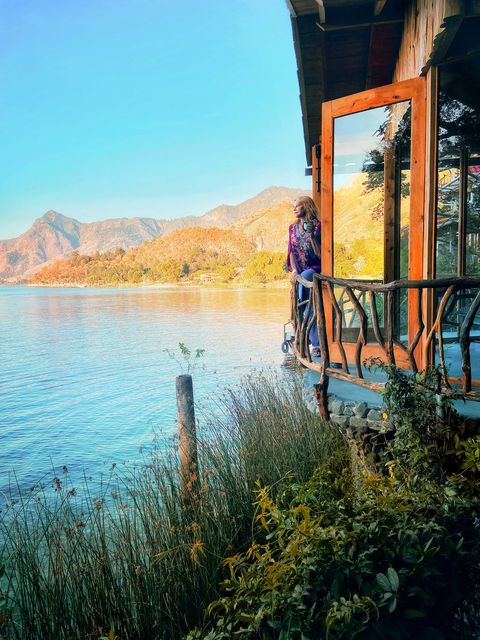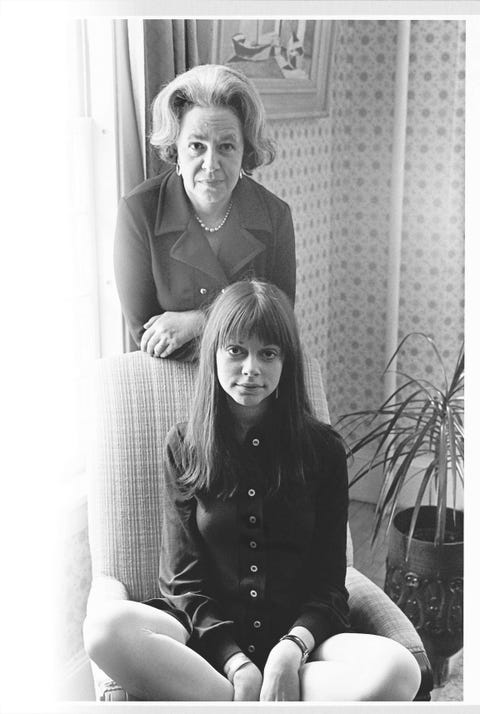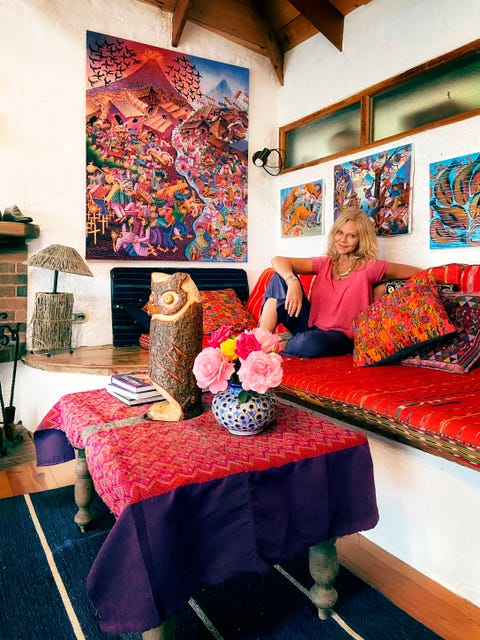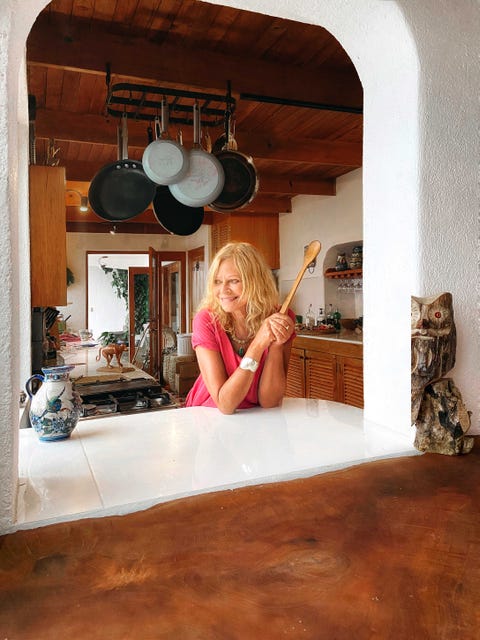So you’re an 18-year-old girl who, based on one photo and article, has been anointed the Voice of Your Generation; you attract the attention of a world-famous 53-year-old literary sensation. You correspond; he invites you to live with him, as one does. Your mother, herself a brilliant but thwarted writer, would not be pleased if this were some schmo. This is not some schmo. You are her finest creation, and the Great Man wants you. So you drop your scholarship at Yale; your mother sews you an alphabet-print A-line dress that makes you look like you’re 12; and you present your skinny self (your mother is very proud of that, too) at the home of the great man. Your favorite prep-school teacher drives you there. Nobody thinks this is a bad idea.
Then, weirdness happens. The famous writer has you eating undercooked meat and teaches you how to throw up, since he seems to prefer that pre-adolescent body. Posing as a “concerned friend,” he takes you to a homeopathic doctor to cure you of the vaginismus you suffer while you’re with him, making intercourse painful or impossible. The treatment doesn’t do the trick, and so, after nine months, you’re kicked out. You can’t have an intimate relationship with anyone for a very long time afterward, because you carry the deep and abiding secret of a nonfunctioning vagina.
Many years later, you write about all of this. And naturally, the famous writer faces the wrath and condemnation of an outraged public who sees his creepiness and rapaciousness for what it is.
Or wait, no, maybe that’s not how it happened. Maybe, instead, you are canceled. After your memoir At Home in the World comes out in 1998, you appear at a writers’ conference, and an entire fleet of prominent authors walks out. You sell the letters written to you from the great man at auction to pay for your kids’ college educations. The purchaser, a diehard fan, announces publicly his intention to return the letters to their author, J. D. Salinger. At the time, Maureen Dowd calls you the “Leech Woman of the boomer generation.”
“You’re right,” Joyce Maynard says, as I suggest that maybe her origin story with J. D. Salinger would be looked at very differently in the #MeToo era.“There’s a lot about the #MeToo movement I welcome and celebrate, but of course, it’s not retroactive.” The criticism, she suggests, will always be there:“I’m locked into the Google universe as the person who slept with Salinger…whose chief function as a writer was to convey marginal information about the truly important person.”
Still, for all that’s happened since, she is proud that at that time her body had a wisdom of its own. “Vaginismus means that you don’t feel safe. That your body is saying, ‘I don’t think so.’ ” Pre-Salinger, Maynard had never had sex with anyone, never seen a man naked. “My father was in the advanced stages of alcoholism. My mother didn’t protect me. My English teacher from Phillips Exeter delivered me to him. The only protection I had was my own body shutting down, closing, slamming shut.”
That may have been the last time any part of Joyce Maynard slammed shut.
Maynard is Zooming with me from her lakeside home in Guatemala; the occasion is the publication of her tenth novel, which comes out next month. Count the Ways is a sweeping saga of marriage and family, with all its love, loss, betrayal, disappointment, and forgiveness. At 67, Maynard is graceful and restless, gesturing dramatically as she speaks, tucking and untucking her legs. She has the same saucer eyes that stared out from the cover of the New York Times Magazine in April 1972. She is wearing yoga pants and a Johnny Was embroidered tunic that looks so festive I spend an hour after our call tracking it down on eBay.
“I have a reputation for being this oversharer,” Maynard says. “I find that a fascinating term. What does oversharing mean, really?”
Well, it means that you have chronicled every infidelity, abortion, rape, betrayal—“one damn hair ball at a time,” as the writer Caitlin Flanagan once put it. It means you do well-intentioned, but arguably impulsive and sometimes regrettable, things (adopting two Ethiopian sisters and then rehoming them comes to mind) and then commit them to the page. It means you don’t sanitize shit, both figuratively and, in Maynard’s case, literally. (She wrote about the fecal transplant that she gave to her dying husband to cure him of a raging infection, and yes, it worked.) And if you do all of this very well, as Maynard does, it means that you can make people uncomfortable. Among fellow memoirists, she is alternately mocked and envied. I’m too embarrassed to tell her this, but over the years, when I feel I’ve written something that is just a little too personal, my standard question to editors is, “Am I becoming Joyce Maynard?”
In fact, becoming Joyce Maynard was not so easy. She grew up in New Hampshire, the child of “brilliant, passionate, artistic spirits who were completely sidelined in their careers,” she says.“My job in life as a young person was to make my parents happy in whatever way I could; to keep my father from drinking and deliver to my mother the kind of success that had eluded her.”
She started being published in magazines at 14. Professional success came easily; it was family happiness that remained elusive—and indeed, she says, it’s been the driving force in her life. After briefly retiring to a farm in New Hampshire after her affair with Salinger ended, Maynard moved to New York City and eventually became a reporter at 21 for the New York Times. One day, when she was 23, she was summoned into legendary editor A. M. Rosenthal’s office and asked what exactly she wanted to do at the paper, just name it. She said, “Well, actually, I want to move back to NewHampshire and have babies; I’ve fallen in love.” And that’s what she did.
“That’s not something a woman did in 1977,” she says. “I don’t call myself a feminist. [But at the same time,] I don’t know where we got the idea that if you like to cook, if you like to have babies, that’s antifeminist.” I’ve adopted Maynard’s definition of feminism as my own. “For me, being a feminist,” she writes, “means manifesting the strength and confidence and tenacity to pursue whatever it is you most want to do…. In my case, the goal was having a family.” But with the strength to buck convention, there is also, very often, calamity. “I think it’s useful to consider how many terrible things can happen, and you can still have a wonderful life,” Maynard says.
I can’t help noting, when we talk about the role disaster plays in her work, that the view outside her window is of an active volcano. Her home is a gorgeous riot of color—Guatemalan textiles inside, and roses, cacti, and orchids outside. A large mural in her house, which she commissioned from a local artisan, offers a visual compendium of every bad thing that could possibly happen to you in her little town. “Okay, let’s see,” she says, a little gleefully: “Flood, volcanic eruption, tuk-tuk crash, truck going over the edge of the water, a swarm of bees, rabid dogs.”
More and more as she’s gotten older, Maynard has seen the way terrible loss can be humanizing. Before their brief, happy marriage, and the tragic death of “the good husband” chronicled in The Best of Us, Maynard was “hung up on her old story,” the idea that everything in love had gone wrong for her. But having a love that worked, even with the loss—perhaps because of the loss—made her see that “I would not be alone forever, that I need to love somebody. That’s almost more important than being loved.”
She reveals there’s a new boyfriend in her life—“a runner, very peppy, who does not discuss hip replacements with me.” They met on match.com—the same way she met her late husband. “I like to tell people about [how I met both of them online] because I think it’s inspiring,” she says.“[Before I met both of them], people had seen me knocking around—alone, unattached, or disastrously attached. I was looking for torment, and somebody really interesting and kind of dark. Finally, I was ready for a man who walked on the sunny side of the street.”
She has already started working on another book about going back to Yale as a student in her sixties. It is no small thing, to be perceived as the voice of your generation, witnessing the wonders—and challenges—of a new generation.
“I worry about some of these brilliant students. They were raised to get to Yale, to stay at Yale. The big crisis in their lives, for many of them, came when the pandemic arrived and they didn’t have the structure of school, which was all they’d ever known.”
Maynard worries that many of these young students seem to lack resilience—a characteristic she possesses in spades. “I think this is probably the trait that has served me best in life. I have been utterly crushed a number of times, but I tend not to stay crushed. I’ve always picked myself up.”
Especially when it comes to love. It wasn’t until she was 60, she says, that she understood what it was to love. Lately, Maynard has become obsessed with tennis, even though she says she’s a lousy player. “It’s that back-and-forth—I love the idea of two people connecting [on the court].”
“You can dance alone. I do dance alone. But you can’t play tennis alone.”
This article appears in the June/July 2021 issue of ELLE.







